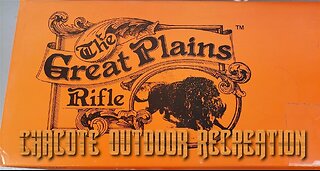Premium Only Content

Lewis H. Morgan noted that tipi frames were 13 to 15 poles that were 4.6 to 5.5 meters (15–18 ft) tall. These poles, "after being tied together at the small ends, are raised upright with a twist so as to cross the poles above the fastening. "The builders pull the lower ends out to form a circle about 3.0 metres (10 ft) in diameter on the ground. They stretch a covering of tanned and untanned buffalo hides, sewn together, over the frame, which they then secure with stakes at the base. "At the top there is an extra skin adjusted as a collar, so as to be open on the windward side to facilitate the exit of the smoke. A low opening is left for a doorway, which is covered with an extra skin used as a drop. The fire-pit and arrangements for beds are the same as in the Ojibwa lodge, grass being used in the place of spruce or hemlock twigs. Lodgepole pine is the preferred wood in the Northern and Central Plains and red cedar in the Southern Plains. Tipis have a detachable cover over the structure. The cover has historically been made of buffalo hide, an optional skin or cloth lining, and a canvas or bison calf skin door. Modern lodges are more often made of canvas.
-
 7:48
7:48
Chacote Outdoor Recreation
5 months agoGPR With Sights
33 -
 31:23
31:23
MYLUNCHBREAK CHANNEL PAGE
23 hours agoThe End of The Century
5.67K3 -
 40:07
40:07
Film Threat
7 hours agoLIVE FROM AFM IN LAS VEGAS! IT'S AN INDIE MOVIE REVOLUTION! | Film Threat Livecast
9.94K1 -
 2:10:38
2:10:38
Slightly Offensive
4 hours ago $10.55 earnedDonald Trump's Plan to SAVE AMERICA.. Will it WORK?
31.4K1 -
 2:37:28
2:37:28
I_Came_With_Fire_Podcast
14 hours agoNAVY SEALS, THE PLAYBOY MANSION, AND RAISING TOUGH GENERATIONS (Watch Party)
98.3K12 -
 1:32:00
1:32:00
Michael Franzese
15 hours agoWhat comes next from the Teflon Don?
67.2K30 -
 LIVE
LIVE
Major League Fishing
1 day agoLIVE: Toyota Series - Championship
653 watching -

Vigilant News Network
7 hours agoTrump Outlines His Plan to DESTROY the Deep State | The Daily Dose
71.8K -
 2:49:36
2:49:36
The Jimmy Dore Show
1 day agoRumble Time Live w/ Jimmy Dore & Special Guests Roseanne Barr, Dr. Drew, Drea de Matteo & More!
354K294 -
 3:54:42
3:54:42
The Wonton Don
8 hours agoDonnie Does: Live with the Traveling Backpack
121K4